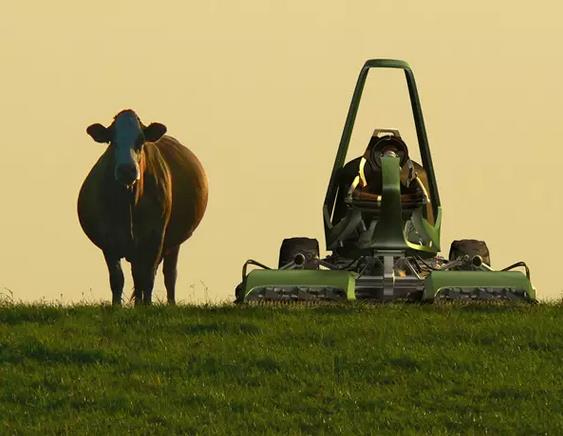概念割草机工业设计-只吃草不烧油
现有的割草机燃料燃烧效率低下,对环境污染严重。想想,这个世界上有多少公园,花园,高尔夫球场和乡村俱乐部,它们的草坪修剪通常每周三次,这是一个很大的环境成本。
这个设计目的是减少这些燃料成本:将割草机割下的草作为生物燃料。技术的灵感来自大自然最高效的移动化学发酵动物——牛。
像牛一样,吃大量的草,把它压缩成生物反应器。这种生物反应器通过发酵产生大量甲烷气体,并用作割草机的燃料。
从设计的角度来看,希望解决的几个问题。
1、更好地履行经营者的性能要求;
2、舒适的人体工程学设计;
3、与众不同的审美;
4、在力学方面,采用三轮结构,转弯半径小;
5、更良好的操作界面。
A recent study by the American EPA showed that a typical commercial mower emits the same amount of pollution (other than CO2) in one hour as driving a 1992-model car for 650 miles. Another estimate puts the minimum amount of pollution from a lawn mower, per hour, at four times the amount from a car. This is caused largely by incomplete combustion and an almost total lack of catalysts or filters on lawn mower exhausts.
Now, think just how many public parks, gardens, golf courses and country clubs there are in the world, and consider that they are mowed as often as three times a week. That’s a lot of fuel being inefficiently burned, at great cost to the environment – and in many cases, the taxpayer.
My project aim was to cut these fuel costs, with a lawn mower that uses a completely renewable energy source – grass. This lawn mower is fuelled by its own grass cuttings using a small-scale bioreactor. The technology is inspired by nature’s most efficient mobile chemical fermentation plant: the cow.
Like the cow, the Lawn Moo-er ‘eats’ a quantity of the grass cuttings and compresses it into the bioreactor. This bioreactor anaerobically ferments the grass with heat and a bioculture compound to produce vast quantities of methane gas.
Unlike the cow, the methane is put to use rather than emitted. It is captured and used as a clean-burning fuel in a small highly efficient gas combustion engine, which, in turn, powers the lawn mower. The by-products of this process are heat, which is reused, and a damp organic mulch, which is scattered behind the mower as fertiliser. At the start of the season the operator loads the mower with one full methane gas canister and one empty. From then on, as one empties, the other fills up and vice versa. The natural fermentation process is speeded up by mixing the shredded cuttings with a potent microorganism-infused bioculture and heating the resultant soup to around 70-80°C.
The onboard fermentation cycle can, in theory, begin to produce methane the same day the grass is cut. The Lawn Moo-er continually runs its fermentation process, constantly topping up the methane supplies, even when a traditional lawn mower has inactive downtime. You really can just go and mow.
From a design point of view I was keen to address a few issues. Over many years of patient development, mowers have gradually evolved to better fulfil their operator’s requirements with regards to performance and comfortable ergonomics. However, there has not been much consideration about the aesthetics. I wanted to create a new, instantly identifiable aesthetic that kept all the practicality of a working agricultural vehicle, yet differentiates my concept from the current crop of lawn mowers, to highlight the unique powerplant.
In terms of mechanics, I elected to use a three-wheel configuration with the steered single wheel on a rear swing arm for manoeuvrability. It can turn around within its own length with ease. As of 2009 it has become UK law for commercial lawn mowers to be sold with rollover protection as standard, rather than as a bolt-on extra. I wanted to highlight this and go for something that brought attention to the cage and integrated it into the design as a whole.
The main styling inspiration throughout the project was the cow. I wanted the mower to have the same purposeful, forward-leaning stance as a cow when it is grazing. I also used specific graphical elements as reference points for the detailing. The floor mats, for example, are styled to look like a cow’s nostrils. I also looked to grass itself as inspiration and used the shape of individual blades to inform the styling of the cage and steering column.
I was also keen to simplify the user interface for the operator, as I found the controls on commercial mowers I tested to be less than instinctive and beyond the line of sight of the operator. The main controls are consolidated into a steering wheel, two foot pedals and two mower control switches. All the major and minor displays are compiled into one digital interface set into a fixed-hub steering wheel boss. Here it is always to hand and the operator can see, at a glance, exactly how much fuel has been used or how long it is until lunchtime…











